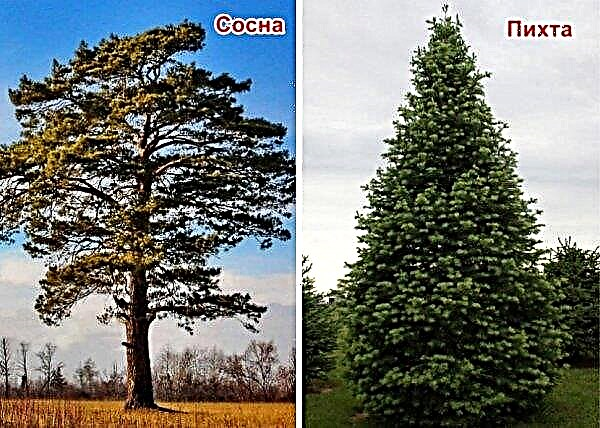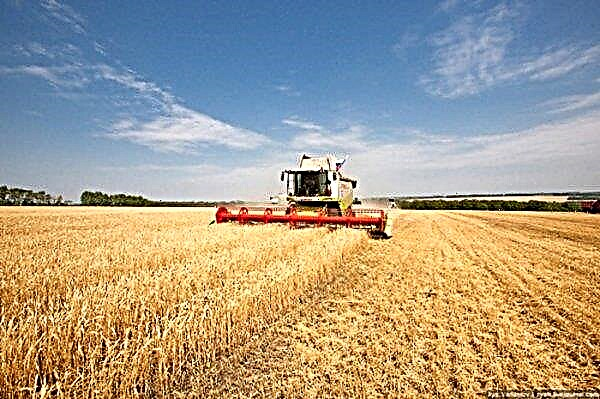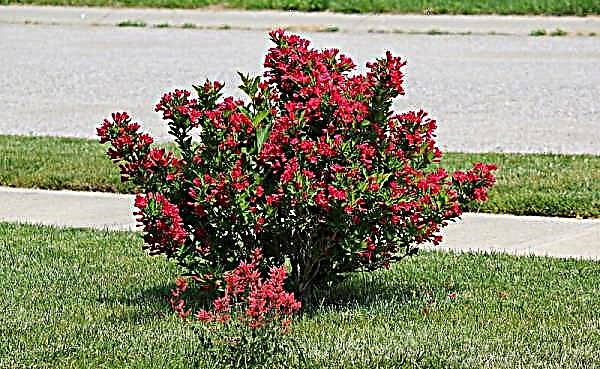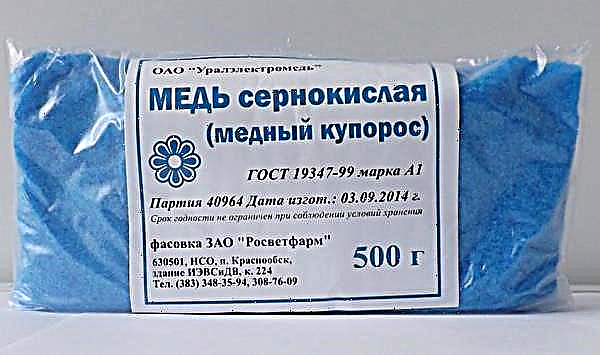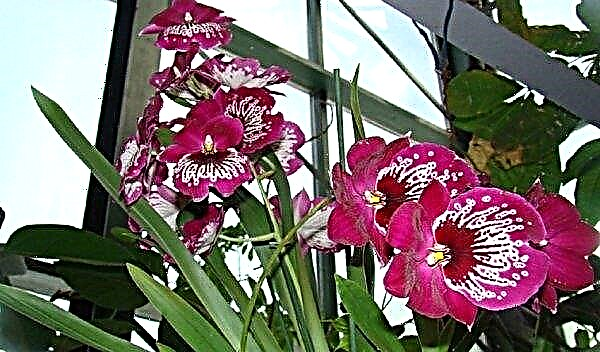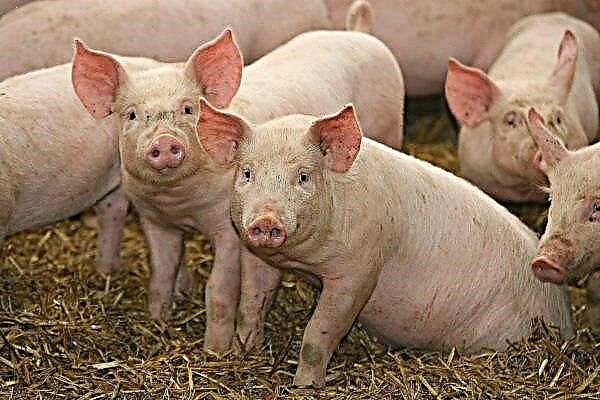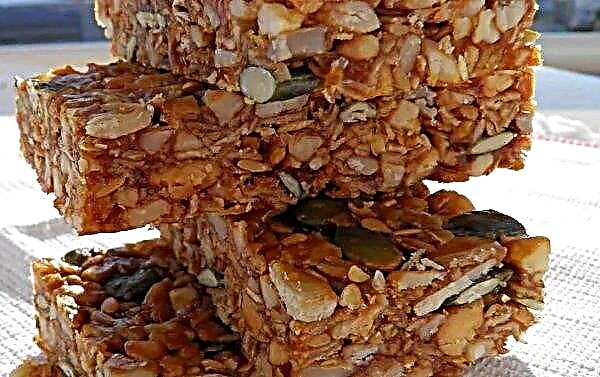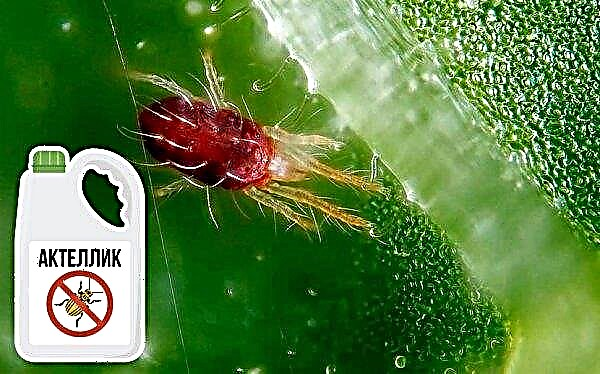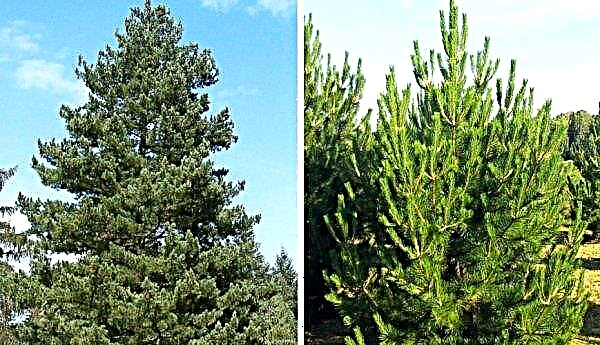Thanks to a variety of cold-resistant hybrids, cherries are able to actively bear fruit everywhere, therefore, gardeners are increasingly resorting to cultivating it in their areas. However, among the abundance of varieties, choosing the most suitable is not so simple. This article will detail the main features of the Bryanskaya Rosova variety, as well as its main advantages and disadvantages.
Botanical grade description
Bryanskaya Pink is a late-ripe hybrid of cherries bred in the walls of the All-Russian Research Institute of Lupine (Bryansk Region). The basis of the new hybrid was the seedlings of the Muscatal Black Cherry, which, due to lengthy selection work, were transformed into a new, high-yielding hybrid. Zoned variety for cultivation in the Central climatic region (the territory of the Bryansk region and adjacent areas).
 Sweet cherry Bryanskaya Pink - a typical representative of the family Pink. This is a plant with a straight trunk and a spreading crown, belonging to the trees of the first magnitude. Cherry is quite fast growing and comes into fruition 5 years after planting
Sweet cherry Bryanskaya Pink - a typical representative of the family Pink. This is a plant with a straight trunk and a spreading crown, belonging to the trees of the first magnitude. Cherry is quite fast growing and comes into fruition 5 years after planting
The tree has shoots of 2 types: auxiblasts and brachyblasts. The first are distinguished by pronounced internodes, as well as large sizes. The second are shortened processes with weakly pronounced internodes. Flower buds often develop on them, which is a characteristic feature of all representatives of culture.
Cherry is considered a close relative of the more common cherries, but it has characteristic features. First of all, the tree is distinguished by a tall stem with whorled branches. Cherry also has more elongated and bright leaves, strongly pointed at the edge.
Did you know? Sweet cherry is one of the oldest fruit trees. The history of cultivation of this plant as a separate species has more than 2 thousand years.
Characteristics of berries and tree
This hybrid is characterized by small size (up to 3.5 m in height), as well as a restrained type of growth. On an even cylindrical stem, a raised, rather strong and dense, wide-pyramidal crown is formed. It is formed by smooth branches with a smooth surface, light brown in color. They are directed at an acute angle relative to the trunk.
 Small fruits of Bryansk pink have a dense pink-yellow skin and light flesh
Small fruits of Bryansk pink have a dense pink-yellow skin and light flesh
The plant blooms profusely, at this time three-flowered inflorescences are formed on it. Individual flowers are small, white, the petals in the flowers are located freely. The ovary is formed on annual or bouquet branches. It transforms into small fruits-berries of stone fruit type. The fruits of the plant are small, rounded, weighing up to 6 g, pink-yellow hue. The average size of one ripe berry is 2.1 × 2 cm (W × H).
The flesh of the fruit is yellow, on the cut - juicy, but dense. The taste characteristics of the pulp are excellent: it is quite sweet, with moderate acidity and light bitterness. The tasting characteristic of the crop is about 4.1 points. Berries are characterized by excellent keeping quality, so the crop is suitable for long transportation.
 The average tree yield is in the range of 20–25 kg / plant, which is about 60 kg / ha
The average tree yield is in the range of 20–25 kg / plant, which is about 60 kg / ha
Advantages and disadvantages of the variety
- The main advantages of sweet cherry Bryanskaya Pink:
- restrained growth;
- fruiting occurs already in the 5th year after planting;
- wood resistance to sunburn;
- high product characteristics and productivity;
- natural resistance to claustosporiosis, coccomycosis and moniliosis.
- The main disadvantages of the hybrid:
- berries can be affected by rot;
- self-infertility;
- low frost resistance of the ovary.
Features and landing rules
Despite the preparedness of this cherry for a temperate climate, some rules must be observed during planting. They provide for the selection of optimal planting dates and location on the site. Thanks to this, you can create a suitable microclimate in the garden that promotes the active growth and fruiting of the tree.
Video: Cherry planting instructions
Optimal timing
According to the general rules of agricultural techniques for growing fruit trees, they are planted in early spring or late autumn. However, when planting Bryanskaya Rozova, one must take into account some physiological characteristics of the plant, as well as low cold resistance of the species. In this case, the best time to plant this cherry is early spring.
The procedure begins immediately after the upper 50 cm layer of soil is completely frozen. In the temperate climate zone, this period lasts from mid-February to mid-March.
Important! When planting cherries, the average daily temperature should not fall below + 5 ° C, otherwise the seedling may freeze.
Seat selection
Cherry develops best in open and well-lit areas, protected from drafts. The most suitable for this are considered the southern and southwestern parts of the garden, located in the fence or on the sunny side of the garden buildings, at a distance of at least 5 m from the fence.
You can plant cherries near other fruit trees, while they should not shade seedlings. Therefore, a place for a hole is better to break no closer than 3 m from tall vegetation. Also, the culture does not like the lowland, therefore, in the tree planting zone, a small mound up to 50 cm high should be poured.
 For the planting of cherries, the sunniest places are chosen, protected from sudden gusts of wind
For the planting of cherries, the sunniest places are chosen, protected from sudden gusts of wind
Site preparation
For the safe growth and development of sweet cherry, Bryanskaya Pink requires a well-fertilized loamy substrate, prepared in a special way. Begin such a procedure approximately 2 weeks before landing.
To do this, the soil must be carefully dug to a depth of at least 30 cm, and then cleaned of residual vegetation and debris. After that, 10 kg of manure, compost or peat, 30 g of superphosphate and 20 g of potassium chloride should be added to the soil, per 1 m². After this fertilizer is mixed well with the soil and create a small mound.
 If the site is dominated by sandy soil, clay is introduced into the soil, in the case of clay soil, on the contrary, it is lightened by sand. In this case, dilution is carried out with a calculation of 1 bucket / m²
If the site is dominated by sandy soil, clay is introduced into the soil, in the case of clay soil, on the contrary, it is lightened by sand. In this case, dilution is carried out with a calculation of 1 bucket / m²
Direct landing
Planting a cherry seedling consists of the following stages:
- Dig a hole 60 cm deep and about 70 cm in diameter on the site.
- Drive a peg into the bottom of the hole, which in the future will serve as a support for the young tree.
- Then fill the pit with soil mixed with fertilizers by a third.
- Place the cuttings in the ground. This should be done so that the root neck is at a height of about 5 cm above the ground.
- In this case, the roots must be straightened out, avoiding damage and breaking.
- After the seedling is in the pit, the root system is densely covered with a substrate.
- Around the plant, make a small indentation with a diameter of 30-40 cm, in which the moisture necessary for the cherry will accumulate.
 As soon as planting is completed, 3-4 buckets of water should be gradually poured under each seedling
As soon as planting is completed, 3-4 buckets of water should be gradually poured under each seedling
The subtleties of tree care
To achieve the ripening of high-quality and juicy berries, cherries must be carefully taken care of. This involves the creation of a specific system of humidification, top dressing and other agricultural techniques, including protection against possible pests. Thanks to this, the tree will take root as quickly as possible and will delight with increased productivity.
Did you know? Cherry is considered a long-lived tree. Despite the fact that cultural forms have been living for no more than 40 years, wild species from the natural habitat region (Mediterranean, Asia Minor) are able to grow and develop over 300 years.
Watering
In the 1st year after planting, the plant requires abundant watering, so moisturize it every week. Adult trees are watered no more than 3 times per season: at the beginning of flowering, at the time of the appearance of buds, as well as in the ripening phase of the fruit. In the case of a particularly hot summer, additional irrigation is carried out, it is done from the second half of September to mid-October.
Plantations under the root are watered in the trunk circle. For young plants in the first 1-2 years, no more than 10-12 liters of water will be required, and as the tree grows older, the norm is increased to 50-60 liters.
 Only clean and settled water is used for irrigation, and in the summer it must be warmed up to ambient temperature in order to avoid overcooling of the root system
Only clean and settled water is used for irrigation, and in the summer it must be warmed up to ambient temperature in order to avoid overcooling of the root system
Top dressing
Within 1 year after planting, the cherry does not need additional fertilizing, therefore, fertilize the tree begins only from the 2nd year. In the 2nd and 3rd season, the cherry is fertilized 3 times. The first top dressing is performed during flowering, and then the rest of the feeding is done with an interval of 10 days. A carbamide solution is used for this at the rate of 30 g / 10 l of water. The flow rate of the working fluid is 10 l / plant.
In the 4th year, the tree is fertilized twice: in early spring and in the second half of August. In the spring, 150 g of urea is introduced into the near-stem circle, in the fall - 300 g of superphosphate and 150 g of potassium sulfate. Mineral fertilizers are carefully dug into the soil, after which the site is spilled with 10 liters of water.Important! In the 1st year of flowering from cherries, it is recommended to cut off all the inflorescences - this will help the plant direct all its forces to effective rooting.
By the 5th year, a stable feeding regimen is created for the tree. In early spring, 150 g of carbamide is introduced into the near-stem circle, and in September each sweet cherry receives 400 g of superphosphate, 200 g of potassium nitrate and 4-5 kg of humus.

Whitewash
Whitewashing a sweet cherry stem is not a vital procedure, but most growers are advised to resort to it. It helps protect the tree from various pests, as well as avoid sunburn of the bark. This is especially important for young plants, whose integument is often not able to cope with the intense exposure to solar radiation.
The first whitewash is carried out after planting, and then, as the cover layer is used up, it is updated. For whitewashing, hydrated lime diluted to a semi-liquid state is used. The entire trunk of the plant is whitened, starting from the basal zone and ending with the first tier of branches
The entire trunk of the plant is whitened, starting from the basal zone and ending with the first tier of branches
Pruning
Cherry pruning begins already in the 2nd year after planting. This helps to form a compact fertile crown with a maximum number of fruit branches.
Important! Sweet cherry Bryanskaya Pink requires a pollinator on the site. The best varieties for this are Iput, Tyutchevka, Revna and Ovstuzhenka.
Pruning is done so as to give the crown of the tree a tiered form with a sparse structure. At the same time, the lower tier is formed of 3 branches, the middle one is made of 2, and 1 vertical shaft is left at the top. All other lateral branches are removed, while pinching the top is carried out when the tree reaches a height of 3 m.

Starting from the 5th year, cherries do sanitary cleaning and thinning. Unnecessary, old, dry and damaged branches are subject to removal. Regardless of the type of pruning, carry out this procedure in early spring, before the leaf buds open.

Diseases and Pests
Despite the increased resistance of the variety Bryanskaya Rosova to a variety of diseases, probably every gardener encounters the problem of ailments. There can be a lot of reasons for the occurrence of pathologies, but often this problem arises in case of non-compliance with the conditions for growing the culture. Excessive humidity, unadjusted fertilizer application, as well as adverse neighborhoods can cause damage to the tree by dangerous microorganisms and harmful insects.
The main diseases of culture are considered moniliosis, coccomycosis, chlorosis and ascochitosis. When these ailments appear, the cherry should be sprayed with Abiga-Peak or Khom preparations 1-2 times. Alternatively, you can use a 1% solution of Bordeaux mixture.

Also among plantings are found gummosis and fruit rot. They fight these ailments by treating the affected plants with 1% copper sulfate. For prevention, once a month, the cherries are also sprayed with 1% copper sulfate or Bordeaux liquid. As a more reliable protection, the Hom drug will serve.

Of the pests, the greatest danger to cherry plantations is aphid and sawfly. For aphids, the most effective treatments are Actelik and Inta-Vir. The treatment is carried out twice, with an interval of 14 days. A solution of 10 liters of water and 250 g of tobacco dust, which also sprinkles a sick plant abundantly, is considered safer for the plant. And against the sawfly, the insecticides “Pyriton” or “Iskra-M” will help, with a flow rate of working fluid within 3-4 l / adult tree.
To prevent pest attacks, once every 25 days the plantings are treated with the choice of Fitoverm, Askarin, Iskra, or interchangeable analogues. Also, for prevention, before the appearance of leafy buds, the trunk and branches of the cherry should be sprayed with a concentrated urea solution. Prepare it from 10 liters of water and 700 g of the drug.

Harvesting and storage
Bryanskaya Rose berries are harvested in the middle or end of July. To this moment, the fruits gain juiciness and acquire a characteristic pinkish-yellow hue. Berries often ripen unevenly, therefore, over the entire ripening period, fruit can be harvested up to 3 times. They are harvested carefully so as not to damage the pulp, otherwise the harvest quality is reduced significantly. If possible, it is necessary to clean the crop from stalks, ovary residues and other contaminants.
The berries are picked up in small containers made of plastic, wood or metal, then they are transferred to common boxes. After collecting them, they must be washed thoroughly under running water, and then sorted out. Whole and undamaged fruits are selected for long-term storage, and the rest require immediate processing. At a temperature of +5 ... + 7 ° С, sweet cherry berries can be stored for up to 2 weeks after harvesting. If the harvest is slightly immature (5–7 days earlier), then under such conditions it will be able to successfully maintain its freshness for up to 3 weeks.
 In favorable years, about 40 kg of berries can be obtained from one cherry of the Bryanskaya pink variety
In favorable years, about 40 kg of berries can be obtained from one cherry of the Bryanskaya pink variety
Bryanskaya Pink is a high-yielding and unpretentious variety of table cherries, perfectly suited for growing in hot and cold climates. This plant is compact, precocious, and therefore can be successfully grown both on an industrial scale and for private farming. The main secret of successful cultivation and propagation of this plant is quality care - the only way to achieve maximum productivity from cherries.

